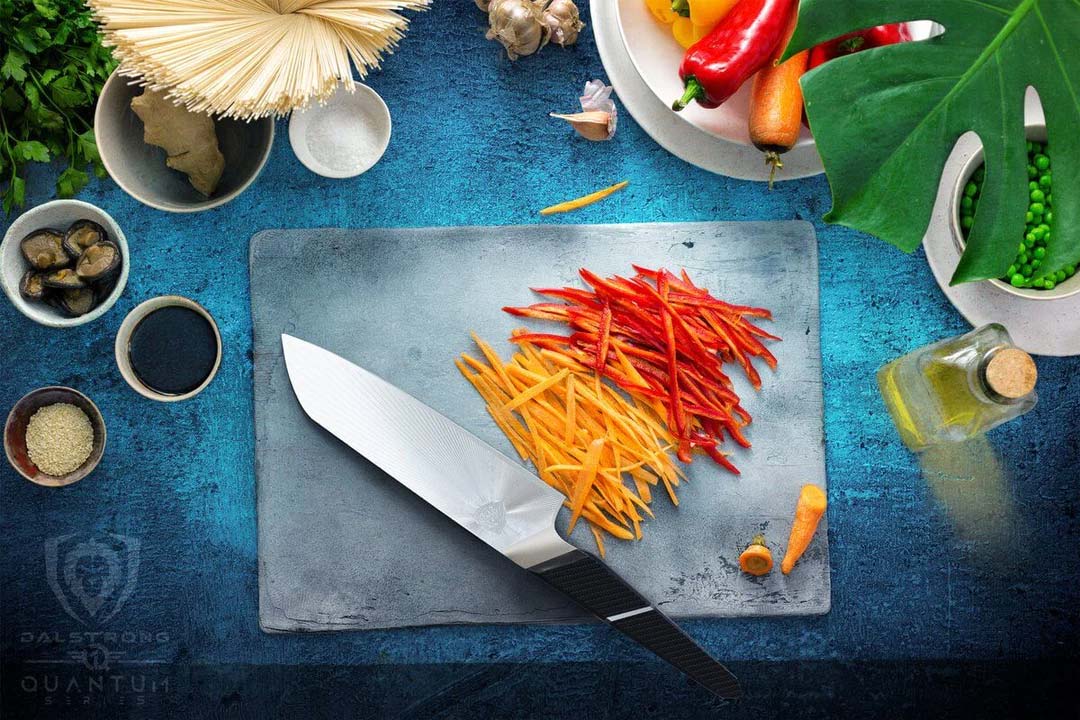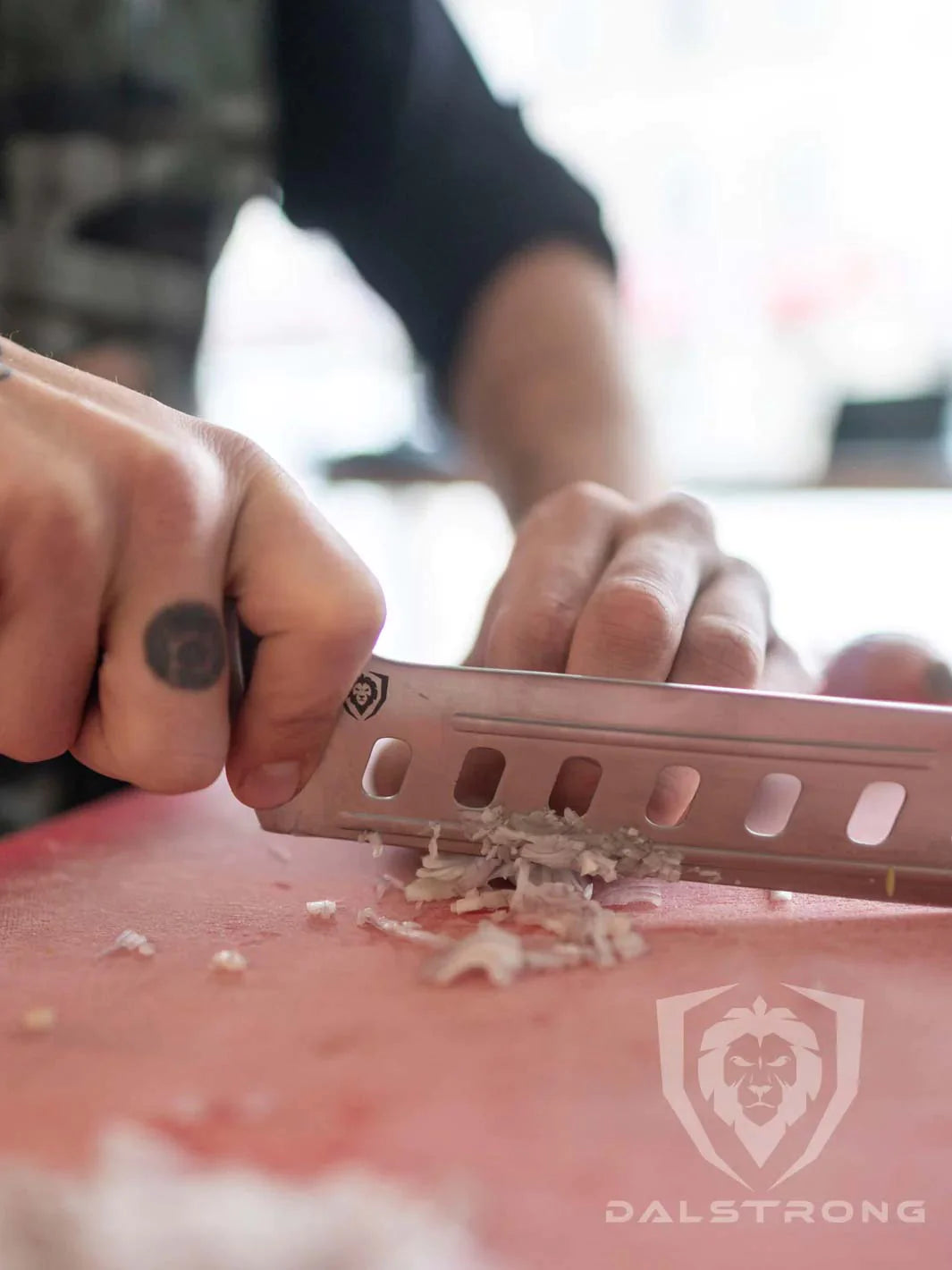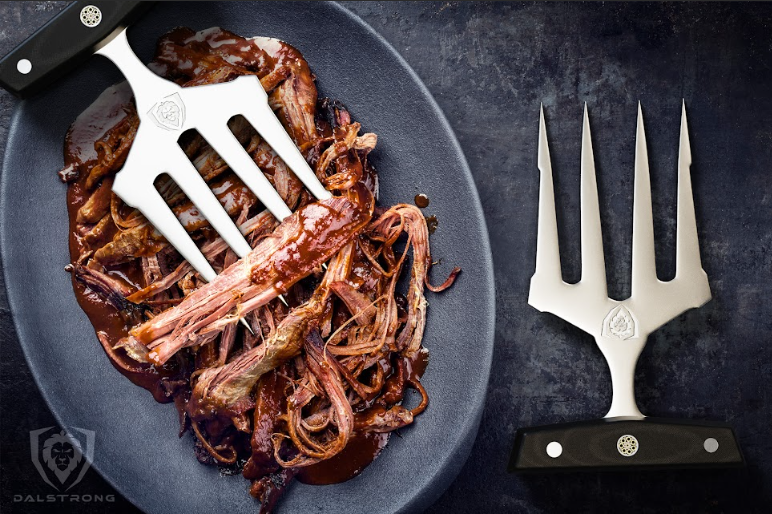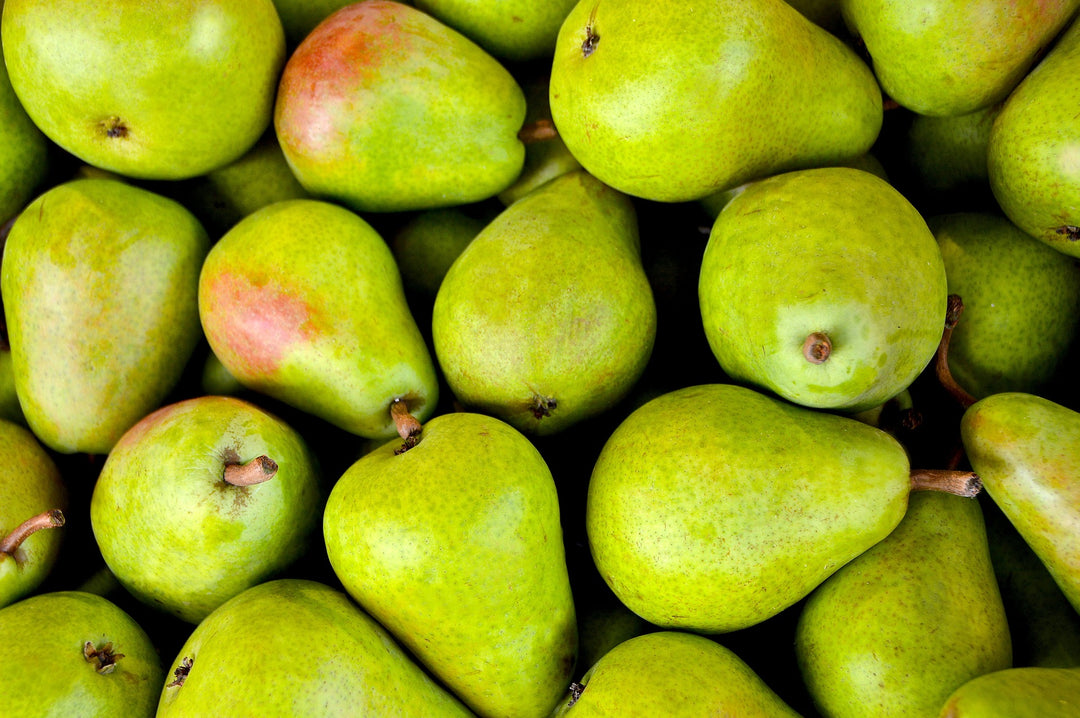How To Cut Brussel Sprouts: 7 Easy Steps
 Chef's Knife 9.5" Firestorm Alpha Series | Dalstrong ©
Chef's Knife 9.5" Firestorm Alpha Series | Dalstrong ©
Quick Overview: How To Cut Brussel Sprouts
- Choose bright green Brussels sprouts for the best flavor and texture.
- Set up a clean cutting board and ensure your chef knife is sharp for easy cutting.
- Take away any damaged or discolored outer leaves from the Brussels sprouts.
- Cut each Brussels sprout in half lengthwise with a precise chef knife.
- For smaller pieces, quarter the sprouts instead of halving them.
- Achieve finely shredded Brussels sprouts using a food processor if preferred.
- Alternatively, finely shred the sprouts using a sharp knife for a hands-on approach.
There’s nothing better than a side of brussel sprouts to go with your side of roast dinners or Thanksgiving plates. Whether it is crispy Brussels sprouts or halved Brussels sprouts for salads, these veggies can elevate the flavor of any plate. When it comes to preparing these nutritious greens, understanding how to cut brussel sprouts is essential. So, let’s get right into it!
1. What Are Brussel Sprouts?

Brussels sprouts, bright green and compact, are a variety of cruciferous vegetables celebrated for their distinctive taste and versatility in culinary applications. These mini-cabbages belong to the Brassicaceae family and are known for their delicious yet nutritious flavor.
Read about the health benefits of brussel sprouts, here.
2. How To Pick Fresh Brussel Sprouts

Start by picking Brussels sprouts that exhibit a vibrant, bright green color. This hue indicates freshness and is a visual cue for optimal taste. The outer leaves should be tightly packed, forming a compact head. The ideal Brussels sprout is firm to the touch, indicating freshness and a satisfying crunch when cooked.
Size
Consider the size of the Brussels sprouts as well. While size preferences can vary, smaller sprouts often boast a sweeter and more tender flavor compared to larger ones. However, the key is to choose Brussels sprouts that are consistent in size, promoting even cooking when it's time to prepare them.
When picking fresh Brussels sprouts, pay attention to the weight of the vegetable in your hand. Heavier Brussels sprouts tend to be denser and packed with more moisture, contributing to a more satisfying taste and texture in your dishes.
Color
When searching for the perfect Brussels sprouts, focus on bright green varieties, cut brussel sprouts, and how to cut brussel sprouts. Use a sharp chef knife on a clean cutting board, ensuring your tools are ready for the cutting process. Trim the outer leaves carefully, and consider halving or quartering the sprouts for different culinary applications.
Look at the surface of the Brussels sprouts for any signs of discoloration or damage. Damaged or discolored outer leaves indicate aging and can affect the taste. A bright green color shows that the vegetable is fresh and organically grown.
3. The Traditional Way To Trim Brussel Sprouts

Trimming Brussels sprouts is a crucial step in their preparation, ensuring that you remove any unwanted parts and present the freshest and most flavorful components for your dishes.
Inspecting and Cleaning
Examine each Brussels sprout individually, looking for any outer leaves that may be damaged, discolored, or loose. These outer leaves often accumulate dirt or debris, so a thorough cleaning is necessary. Gently remove any undesirable outer leaves by peeling them away with your fingers or a knife, exposing the clean layers beneath.
Trimming the Stem End
With a sharp chef knife, trim the stem end of each Brussels sprout. Cut off about 1/4 inch from the base to remove any dry or discolored parts. This step not only enhances the appearance of the sprout but also ensures that the stem contributes to the overall tenderness of the vegetable.
Halving or Quartering
For many recipes, halving the Brussels sprouts is a common technique. Use the chef knife to cut the sprout in half lengthwise, ensuring an even division. If you prefer smaller pieces or need a different texture for your dish, consider quartering the sprouts instead. This versatility allows you to adapt the trimming process to suit various culinary applications.
Ensuring Uniformity
Consistency in size is crucial for even cooking. Aim for uniform cuts to promote a harmonious texture in your final dish. This step contributes to a visually appealing presentation and ensures that each piece cooks evenly, preventing some parts from being undercooked while others are overdone.
Collecting Outer Leaves for Chips
If you enjoy exploring different culinary possibilities, consider saving some of the outer leaves removed during trimming. These leaves can be used to make crispy Brussels sprout chips. Just toss them in olive oil, season with salt and pepper, and bake until they become crispy. It's a creative way to minimize waste and add a crunchy element to your meals.
Kitchen Tips:
- You can coat the sprouts in olive oil, salt, and pepper for roasting or air frying. You can even use the outer leaves for crispy Brussels sprouts, which only adds versatility to this trimming process.
- Hand shredding with a sharp knife is another way to enjoy a hands-on approach in the kitchen.
- If you prefer finely shredded Brussels sprouts, using a food processor is a convenient option.
- Throw some halved Brussels sprouts in an air fryer and enjoy a plate of roasted Brussels sprouts in no time. You can even turn them into a Brussels sprouts salad!
4. Different Methods To Cut Brussel Sprouts

Exploring various methods to cut Brussels sprouts opens up a world of culinary possibilities, allowing you to adapt their texture and appearance to suit different dishes. Whether you're looking for finely shredded Brussels sprouts or halved pieces for roasting, this is how you can nail it.
Hand Shredding with a Sharp Knife
For those who prefer a hands-on approach, hand shredding with a sharp knife offers more control over the texture. Simply slice the Brussels sprouts thinly, creating fine shreds that can be used in a variety of dishes, from sautés to pasta recipes.
Using Different Knife Skills
Experiment with various knife skills to achieve different textures. For example, slicing Brussels sprouts into thin rounds creates a unique presentation and texture that works well in salads or as a garnish. Mastering knife skills allows you to customize the appearance of your dishes.
Blending with Other Ingredients
Combine Brussels sprouts with other ingredients using a food processor to create a blend or mixture. This is particularly useful for making spreads, dips, or incorporating Brussels sprouts into various recipes without their distinct texture being the focus.
5. The Recipe That Will Make You Like Brussel Sprouts
6. Recommended Dalstrong Tools To Use
1. Chef's Knife 8" Valhalla Series | Dalstrong
Crafted from 5-layer stainless steel and honed to a razor-sharp 8-12 degrees, this blade stands ready for the most epic kitchen battles. The celestial resin handle, reinforced with stabilized wood and stainless steel bolster, adds elegance and strength to every slice.
PROS:
- The handle is resistant to extreme temperatures and provides durability.
- The Valhalla-embossed leather sheath ensures the blade's protection.
- The stain-resistant and easily cleaned blade is low maintenance, and ideal for busy kitchens.
CONS:
- Some chefs prefer working with stainless steel handles instead of resin.
- If you’re looking for a smaller knife to work with brussel sprouts, I would suggest a 6-inch knife to begin with.
2. Chef's Knife 6" Gladiator Series | NSF Certified | Dalstrong
The Dalstrong Gladiator Series 6” Chef's Knife is a smaller but robust chef's knife and is a dependable companion in the kitchen. Precision forged from high carbon German steel at 56+ Rockwell, this knife is ideal for heavy-duty and delicate tasks.
PROS:
- Traditional in appearance and true and tried for excellent results on brussels sprouts.
- The ambidextrous and ergonomic black G10 Garolite handle provides maximum comfort.
- The PerfectFit Dalstrong sheath adds convenience and protection when you’re not using the knife.
CONS:
- While the knife is designed for low maintenance, handwashing is best to preserve the polished finish which could add a few more minutes to the cleaning process.
- Some users may find the 6" blade length limiting for certain tasks. An 8-inch chef’s knife could be a better fit.
The Frost Fire Series is meticulously crafted from a 7-layer high-carbon, high-chromium 10CR15MOV steel with added cobalt and expert heat treatment. The blade has a frosted look with a sandblast finish.
PROS:
- Non-stick properties and scalpel-like sharpness at a 16-18° degree angle per side.
- The slender, ergonomic blue resin handle is enclosed in aluminum mesh for durability.
- NSF Certified, ensuring top-notch sanitation standards, perfect for busy kitchens.
CONS:
- Some folks might prefer using paring knives or utility knives for vegetables like brussel sprouts.
- While the knife is highly impervious to heat, cold, and moisture, regular handwashing may be required which makes this a high-maintenance knife.
4. Serrated Utility Knife 6.5" Shadow Black Series | NSF Certified | Dalstrong
This serrated utility knife features a midnight black titanium coating that adds unforgettable styling, sophistication, and functionality to your kitchen. The G10 handle offers incredible grip and dexterity to reduce arm fatigue.
PROS:
- The non-reflective titanium-nitride coating not only enhances the knife's corrosion resistance but also toughens the blade.
- The handle is nearly impervious to heat, cold, and moisture.
- Neatly packed with Dalstrong’s renowned packaging.
CONS:
- The titanium nitride coating can add a few extra minutes to the knife-sharpening process, so if you’re a busy bee, this could seem like an inconvenience.
- Some folks aren’t big on knives with serrations.
5. Utility Knife 5.5" Shadow Black Series | NSF Certified | Dalstrong
At just 5.5" long, it's a versatile mini chef's knife, ready for any slicing task. Engineered for optimal maneuverability, the Shadow Black Series combines exceptional grip with a screamingly sharp cutting edge, boasting a sleek and aggressive design inspired by the F-117 Nighthawk Stealth Fighter.
PROS:
- Precision-forged from high carbon 7CR17MOV-X vacuum-treated steel at 58 Rockwell, the utility knife offers exceptional wear resistance and durability.
- The sleek black appearance makes this knife incredibly special compared to other traditional knives as it will turn heads.
- This utility knife can also be used for other veggie-prepping tasks, making it incredibly versatile.
CONS:
- Some home chefs prefer traditional knives like paring or utility knives instead of hybrid ones.
- The length of the blade could be too short for other vegetables or fruits that are larger in size than Brussels Sprouts.
7. Frequently Asked Questions
What is the right way to cut brussel sprouts?
To cut Brussels sprouts, use a sharp chef knife to trim the stem end, cut in half, and optionally shred or quarter, following precise techniques for uniformity and optimal cooking results.
What part of a brussel sprout do you cut?
When cutting Brussels sprouts, trim the stem end and then halve or quarter the sprout, ensuring you remove any damaged outer leaves for a clean and vibrant result.
Are you supposed to peel brussel sprouts?
You are not supposed to peel Brussels sprouts; instead, trim the stem end, remove outer leaves, and cut or prepare them according to your recipe.
Why do you cut brussel sprouts in half?
Cutting Brussels sprouts in half enhances cooking consistency, allowing for even caramelization and ensuring that the inner layers cook thoroughly while achieving a pleasing texture.





















































































































































































































































